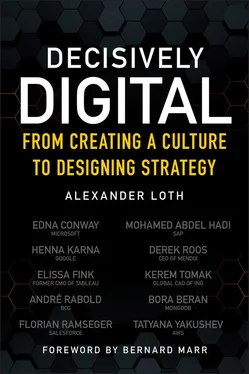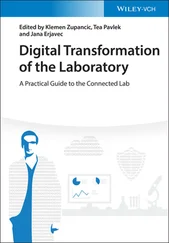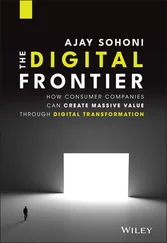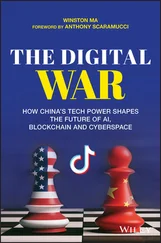The maker culture is based on the strategic topics of artificial intelligence, process automation, blockchain, and Internet of Things (IoT), and it supports citizen data science.
Every organization has a set of core competencies and unique assets. The digital strategy needs to identify specific differentiators that can unlock impact beyond the original core competencies and leverage the unique assets.
Core competencies can manifest in different ways depending on the industry. Unique assets might be physical assets like retail stores, proximity to customers, or intellectual property. While some of these impacts are specific to core competencies and unique assets, some impacts are more generic and can be triggered by fostering a certain culture. Here are some examples:
Attracting new employees, enabled by the collaborative culture
Knowledge generation and exchange, enabled by the collaborative culture and the culture of data-driven decision-making
Understanding customer behavior, enabled by the culture of data-driven decision-making and the culture of citizen data science
Improving products and customer service, enabled by the culture of citizen data science and the maker culture
Reducing time to market, enabled by the maker culture
There are, of course, also certain impacts that cannot directly map to the culture but are conditioned by a strategic topic directly. Here are some noteworthy examples:
Reducing total cost of ownership (TCO), enabled by big data processing and cloud computing
Scalability, enabled by big data processing and cloud computing
Agility, enabled by process automation, blockchain, and IoT
Furthermore, it is possible that impact initiated by a certain culture helps to improve another culture within the organization, for example, by using the insights from remote work data to understand the way the team works (data-driven decision-making) and to modify future tasks and processes for better collaboration (collaborative culture).
Enabling impacts requires continually developing a wide range of digital capabilities. Let's stick with the previously mentioned examples and take a look at which digital capabilities would be required to pursue them.
Attracting New Employees
Unified communications: Using chat and video call beside traditional channels, such as email and phone
Collaboration tools: Working together on notes, documents, spreadsheets, and so on
Remote work: Working from everywhere with secure access to all company resources
Knowledge Generation and Exchange
Self-service business intelligence: Asking your own questions without tying up your traditional business intelligence (BI) team
Visual analytics: Seeing and understanding patterns with interactive visual interfaces 5
Data literacy: Communicating insights for a human-information discourse
Understanding Customer Behavior
Stream processing: Streaming customer feedback and needs in real time
Governed data discovery/mining: Acquiring new or enriching existing data sources that the organization can rely on
Social media ingestion: Improving customer retention by leveraging social media data
Improving Products and Customer Service
Machine learning: Providing the ability to automatically learn and improve from experience without being explicitly programmed
Chat bots and recommender systems: Providing information to users according to their preferences via a chat interface
Human-in-the-loop: Leveraging the power of human intelligence to improve machine learning–based models
Reducing Time to Market
Low-code/no-code: Allowing citizen developers to drag and drop application components, connect them, and create platform-agnostic apps
Application design (UI/UX): Creating products that provide a meaningful user interface (UI) and a relevant user experience (UX)
Cybersecurity: Protecting computer systems from the damage or theft of data, as well as from service disruption
Reducing Total Cost of Ownership (TCO)
Serverless architecture: Eliminating the need for server software and hardware management
Data center transformation: Migrating the on-premise IT infrastructure to a cloud hyper-scale environment
DevOps: Shortening the development life cycle and providing continuous feature delivery
Completing Your Digital Strategy Big Picture
Once you’ve identified the impacts that you want to generate and the corresponding digital capabilities, it is time to complete your digital strategy big picture, as shown in Figure 1.2.
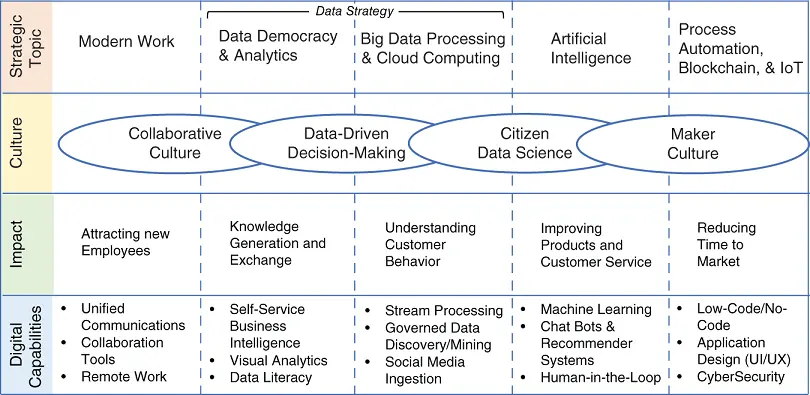
Figure 1.2Digital strategy big picture
This digital strategy big picture serves as reference while you adopt a strategic topic, foster culture, generate impact, and implement digital capabilities. The template is available online. 6
While the first rows, strategic topic and culture, should be fairly static, the impact and digital capabilities vary depending on your industry and your current level of digital maturity and organizational readiness.
Your digital strategy will not generate impact if you don't foster culture or acquire digital capabilities, as illustrated in Figure 1.3. As you will probably not start on a greenfield, it is important to identify and fill the missing pieces to generate impact.
For example, an organization wants to create apps and automate processes faster and therefore sets up a low-code/no-code platform. However, the platform is seldom used because the organization lacks the maker culture. Once the employees are nurtured with workshops, hackathons, and casual training days, many employees gain new ideas and have an intrinsic motivation to pursue them. Soon after, the employees develop many apps (such as an HR chat bot and an employee dictionary) and automate some processes (such as analyzing and tagging incoming email attachments).
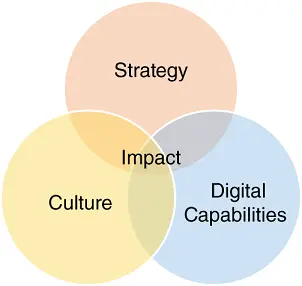
Figure 1.3Impact Venn
Digital Maturity and Organizational Readiness
Acquiring more digital capabilities will increase the organization's level of digital maturity . Providing digital capabilities is just the first step into transforming into a digital business. Helping employees to adopt these new digital capabilities is crucial for any digital strategy.
The level of adoption is called organizational readiness . While some digital capabilities will be adopted more quickly (like unified communications), some digital capabilities require some more training or skilling initiatives (like low-code/no-code). The level of adoption depends on how the organization nurtures the skills of the employees who then drive the innovation process and manifest it into your business processes. This is how you truly enhance your digital capabilities.
These are further aspects to consider that can drive organizational readiness:
Are our employees well connected?
Do we need a center of excellence or user groups?
Does everyone have the resources needed to do their job?
How are people being trained to work in new ways?
Digital maturity and organizational readiness can be tracked as KPIs for your entire digital strategy — or for each strategic topic. Measuring digital maturity and organizational readiness by strategic topic delivers a good indicator that helps you to define or adjust your digital strategy.
Читать дальше
